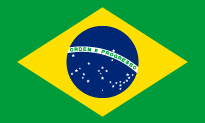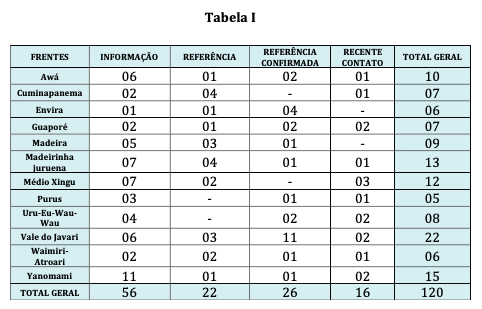
PIACI Diagnosis - Brazil
Preparation of the original document:
ANTENOR VAZ and DOUGLAS A. RODRIGUES (Health)
National Facilitators Brazil – ACTO/IDB Program
2014
INDIGENOUS PEOPLE IN ISOLATION OR INITIAL CONTACT IN BRAZIL
The indigenous population in Brazil is 817,963 people, of which 502,783 live in indigenous lands and 315,180 in urban areas (IBGE, 2010). The 2022 Census is expected to confirm the population trends of the indigenous peoples, but the data is not yet available. According to some authors, this amount is about 27% of the original population existing in Brazil at the time of the arrival of the Portuguese and 0.26% of the total population of Brazil (AZEVEDO, 2013).
With reference to the 1988 Constitution and the principle of self-determination of peoples, the official indigenist body defines as one of its guidelines to guarantee “indigenous peoples and isolated groups the right to remain so, maintaining the integrity of their territory, intervening only when any factor jeopardize their survival and sociocultural organization”.
Currently, FUNAI, from its last restructuring process, has continued the conquests in the scope of protection, adding to the isolated indigenous peoples and those of recent contact the assumptions of the promotion of social, political, territorial and cultural rights, guaranteed in the charter magna.
According to surveys carried out and informed by official bodies, there are in Brazil: 104 records on isolated Indians, of which 56 are classified as INFORMATION ON ISOLATED INDIOS, 22 records are classified as REFERENCE ON ISOLATED INDIOS, 26 records are classified as REFERENCE ON ISOLATED INDIANS CONFIRMED and 16 groups that affect areas covered by the Ethno-environmental Protection Fronts (FPEs) are considered RECENT CONTACT.
Tables 1 and 2 below quantify the communities of isolated Indians identified by region and state.


MAPA INTERATIVO
Observe no mapa interativo do Módulo Povos Indígenas, onde se localizam os territórios indígenas na região amazônica e observe as regiões fronteiriças estudadas pelos consultores da OTCA:
VULNERABILITIES AND THREATS
Brazil, with continental dimensions and with the highest density of references of isolated and recently contacted indigenous groups in the world, located mostly in regions of difficult access in the legal Amazon, has the CGIIRC/FUNAI, the government sector that has the mission of “guaranteeing the necessary conditions for the physical and cultural survival” of these groups. However, despite the achievements made, there is a lack of human and material resources necessary to face the protection of more than 30 Indigenous Lands to monitor in 8 states of the federation (more than 30.5 million hectares), 26 confirmed references of indigenous groups isolated and 16 of recent contact to implement the rights protection and promotion system (without referring to the 22 references and 56 information of isolated groups in which no work is carried out and, consequently, it is not known what happens to these indigenous groups).
The study shows that one of the main immediate challenges is to structure and train public agents and make available more human, material and financial resources that make it possible to duplicate the capacity to act, mainly in regions where there are references and information about indigenous groups isolated or considered to be of recent contact, which are still unassisted.
HEALTH SYSTEMS
Brazil has a subsystem of SUS (Sistema Único de Saúde) for indigenous health care (SASI-SUS). The implementation of this care structure is governed by the National Policy for Health Care for Indigenous Peoples and guarantees the right to differentiated care for the peoples who are in reserves throughout the country, respecting their cultural specificities.
34 Special Indigenous Health Districts (DSEI) were created, after a national process of territorialization and sanitary districting that had indigenous participation.
Indigenous health has become a field of action in which the Ministry of Health has full responsibility for primary care actions at the local level, consistent with the provisions of the Federal Constitution and the Arouca Law, which determine that financing, management and the implementation of the Indigenous Health Policy is the responsibility of the federal government, a characteristic that follows an orientation contrary to the trend of decentralization and municipalization of the Unified Health System and a source of conflicts and contradictions between the SUS and SASI-SUS management instances . (GARNELO and MAQUINÉ, 2013).
Among the SASI-SUS guidelines, in accordance with the National Policy for Health Care for Indigenous Peoples (PNASPI), the following are worth mentioning:
- The preparation of human resources to work in intercultural contexts;
- Proper recording of epidemiological information and monitoring of health actions aimed at indigenous peoples;
- Articulation with traditional indigenous health systems;
- The promotion of the adequate and rational use of medicines;
- The execution of specific actions in special situations;
- The differentiated articulation with specialized services, located at different levels of management, which serve as a reference for specialized assistance (medium and high complexity) and urgent and emergency care;
The promotion of healthy environments and protection of indigenous health;- the social control.
